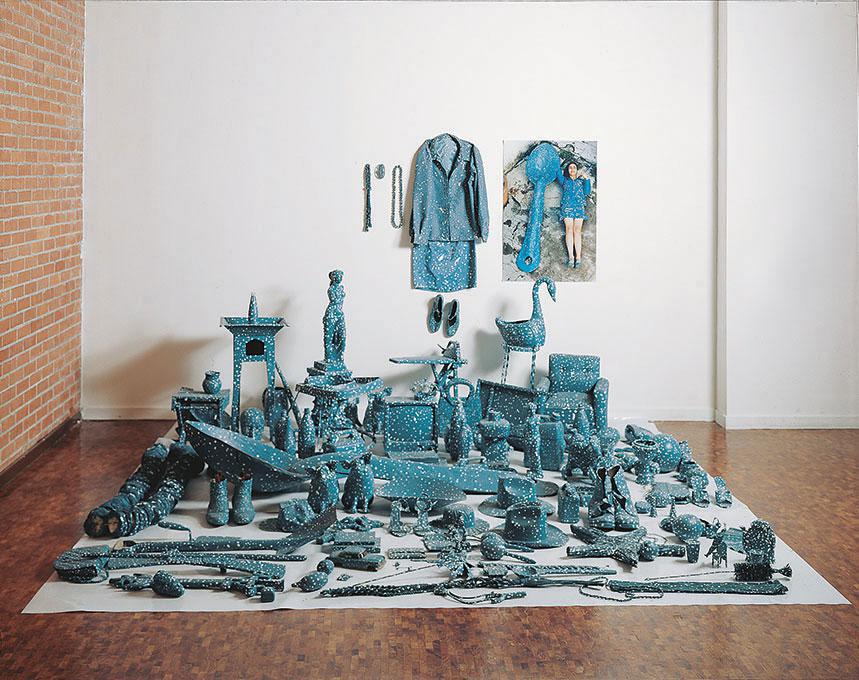To walk the corridors and linger among the exhibits of “The Marvellous Real” is to encounter aspects of Mexico largely unimagined by the hordes of sun- and sand-seekers from above the 49th parallel. This exhibition, currently on view in the Audain Gallery at UBC’s Museum of Anthropology, is a tantalizing survey of works covering 85 years of Mexican art. Most of the works in the show are on loan from the corporate collection of FEMSA, the lead sponsor of the Monterrey Biennial, whose collecting mandate is to acquire and circulate the best of Latin American contemporary art in general, and of Mexican art in particular.
“The Marvellous Real” was curated by UBC anthropologist Nicola Levell, who took as her organizing principles the theories of Cuban writer Alejo Carpentier. Carpentier’s 1926 visit to Mexico as a 21-year-old, during which he met both Diego Rivera and Clemente Orozco, led to his view that the cultural productions of Latin Americans were distinctive from those of Europeans. The encounter prompted Carpentier to reject Surrealism as a term applicable to Latin American art; to him, Surrealism was a Western construct whose roots were found in psychoanalysis and Bretonian manifestoes. Further, he derided the work of Surrealist “dream technicians become bureaucrats” as “a monotonous junkyard of sugar-coated watches, seamstresses’ mannequins, or vague phallic monuments.” Instead, Carpentier wrote, “our own marvellous real is encountered in its raw state, latent and omnipresent, in all that is Latin American. Here the strange is commonplace.”
So, in Carpentier’s view, where the Surrealists looked to the innermost recesses of the subconscious for their material, Latin Americans found it intertwined in the ambiguities and contradictions of everyday life, no less remarkable because it was ordinary. According to Carlos Fuentes, this “spontaneous fusing of myth and fact, dream and vigil, reason and fantasy” has always been an everyday reality in Mexico and Latin America. These contradictions, Carpentier believed, could best be expressed through the baroque, which he defined not as a period style, but as a creative spirit that recurs throughout history, representing the “maximum expression” of a given civilization. With its “horror of the vacuum,” its drama and artifice, light and shadow, the baroque gives artistic form to the myriad hybrid cultural influences at work in the Americas. Canadians familiar with the impulses behind the Group of Seven to establish a distinctive national art may also recognize the desire among some Latin American artists of the same period to find their own chromatics in the landscapes of Mexico and to reclaim their own history.
Organized according to Carpentier’s conceptual categories of “ontologies,” “mythologies,” “technologies,” “ecologies,” and “archeologies,” with each section accorded its own gallery off a central corridor, “The Marvellous Real” cuts across the fractured silos of Western art schools represented at the show’s start with a piece by Adolfo Patiño: Escuelas del arte (Schools of Art) (1992). Its three towers of art history have plinths incorporating piles of books on Marcel Duchamp, Joseph Beuys and Andy Warhol. Entering the exhibition, visitors are seduced by a series of ink-black walls and elegant white moldings that frame selected texts like a salon of the bizarre. At the entryway, a sound recording issues grainily from a gramophone as the grip of the everyday gives way to the delight afforded by rooms filled with works in every conceivable medium. Intermingled with the selections from the FEMSA Collection are pieces from MOA’s own collection of ethnographic objects such as masks, here presented among their compatriots as artworks in their own right.
Among the historical works are pieces by Rufino Tamayo, Leonora Carrington, Tina Modotti, David Alfaro Siqueiros, and Frida Kahlo, whose critical reflection on her time in New York—Mi vestido cuelga aqui (My dress hangs here) (1933)—is rumoured to contain a microscopic face of Lenin on the Statue of Liberty. (Note: this Kahlo work departs the exhibition early, on February 28.) Other standouts include Paula Santiago’s Lim (2000), a fragile dress-like construction made of rice paper, human hair and blood that hovers somewhere in the liminal zone between apparition and accusation. In the same gallery, Miriam Medrez’s folk-inspired tableaux of ceramic figures climbing wooden paddles dipped in sand evokes narratives of migration in Trayectos (Journeys) (1998). Nearby, Eloy Tarcisio’s richly layered painting on felt, Torzos, cabea y corazón (Torsos, Head and Heart) (1992), manages in a single temporal leap to evoke both Aztec human sacrifice and the drug wars.
For those who embrace objects, Betsabeé Romero’s Serpiente (Serpent) (2004)—four rubber tires whose treads have been carved with the motif of the sacred plumed quetzal serpent—will not disappoint, and neither will Claudia Fernández’s El alimento (Nourishment) (1996), an installation of ordinary household objects made extraordinary with excessive speckling, like a domestic universe gone mad for enamelled cookingware. Likewise, to stand in front of Boris Viskin’s massive encaustic Sísifo (Sisyphus) (1994), whose dark and blasted landscape only gradually reveals the presence of a forlorn figure pushing a tiny cart, is to be simultaneously reminded of our tentative existence in the world and to reconsider the achievements of Anselm Kiefer’s work, which seems merely grand by comparison.
“The Marvellous Real” contains many such rewarding encounters, but a single review can only touch on a few highlights. It remains for those fortunate enough to make the journey to the Museum of Anthropology to engage with a Mexico that is complex, poetic and unforgettable.









